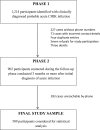Occurrence of Chronic Stage Chikungunya in the General Population of Martinique during the First 2014 Epidemic: A Prospective Epidemiological Study
- PMID: 29848408
- PMCID: PMC6085807
- DOI: 10.4269/ajtmh.17-0543
Occurrence of Chronic Stage Chikungunya in the General Population of Martinique during the First 2014 Epidemic: A Prospective Epidemiological Study
Abstract
Chronic stage chikungunya (CHIK), defined by persisting symptoms more than 3 months after initial diagnosis of acute infection, is frequent. However, its burden and impact have rarely been described prospectively in a general population during an ongoing epidemic in the Caribbean. From January 2014 to January 2015, a severe CHIK outbreak occurred in Martinique. Our objective was to describe epidemiological characteristics and outcomes of chronic stage CHIK in its local population. Participants, clinically diagnosed with probable CHIK infection, were included prospectively by general practitioners during the epidemic's peak from April to October 2014. All identified cases benefited from a follow-up phone call 3 months or more after initial diagnosis during which they were interrogated about persisting clinical signs, past and ongoing treatment, and quality of life. Five hundred and nine subjects participated in the study. Mean age at initial diagnosis was 43.2 ± 23.6 years with a female-male ratio of 1.98. Two hundred participants (39.3%) had probable chronic stage CHIK: 98.5% still experienced pain at least 3 months after acute infection, with 84.3% of reported joint pains; 21.2% were woken up by the pain; 47.2% felt depressed/anxious; and 31.3% experienced memory/concentration disorders. Resumption of daily activity and work was complicated for 55.8% and 36.2% of cases. Persistent impact on morbidity, health outcomes, psychological, and economic aspects further underline the crucial role of community-based medicine and the necessity of an evidence-based multidisciplinary approach toward chronic stage CHIK identification, management, and follow-up in this particular world region.
Figures


References
-
- Robinson MC, 1955. An epidemic of virus disease in Southern Province, Tanganyika Territory, in 1952–53. I. Clinical features. Trans R Soc Trop Med Hyg 49: 28–32. - PubMed
-
- Ramon-Pardoa P, Cibrelus L, Yactayo S; Chikungunya Expert Group , 2015. Chikungunya: case definitions for acute, atypical and chronic cases. Conclusions of an expert consultation, Managua, Nicaragua, 20–21 May 2015. Wkly Epidemiol Rec 90: 410–414. - PubMed
-
- Burt FJ, Rolph MS, Rulli NE, Mahalingam S, Heise MT, 2012. Chikungunya: a re-emerging virus. Lancet 379: 662–671. - PubMed
-
- World Health Organization (Regional Office for South-Est Asia) , 2008. Guidelines on Clinical Management of Chikungunya Fever. WHO Publications SEA-CD-180: 1–17. Available at: http://www.wpro.who.int/mvp/topics/ntd/Clinical_Mgnt_chikungunya_WHO_SEA.... Accessed March 30, 2016.
-
- Couderc T, Lecuit M, 2015. Chikungunya virus pathogenesis: from bedside to bench. Antiviral Res 121: 120–131. - PubMed
MeSH terms
LinkOut - more resources
Full Text Sources
Other Literature Sources
Medical
Molecular Biology Databases
Miscellaneous

